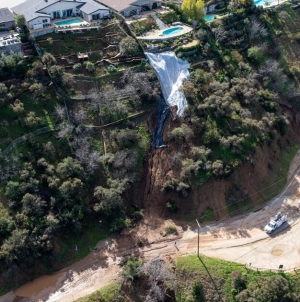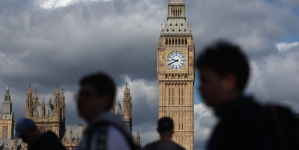-
Iceland Volcano Erupts Near Grindavik After Weeks of Earthquakes - December 19, 2023
-
A portion of Mulholland Drive, damaged by mudslides in winter storms, reopens - May 26, 2024
-
‘Maybe You Don’t Want to Win’ - May 26, 2024
-
Donald Trump Putting Law Enforcement in Danger: Attorney - May 25, 2024
-
Avoid the waters of these 5 L.A. County beaches this holiday weekend, public health officials say - May 25, 2024
-
Bawdy Comedy ‘Anora’ Wins Palme d’Or at Cannes Film Festival - May 25, 2024
-
Map Shows Heat Wave Zone Spread Into Five New States - May 25, 2024
-
Azusa police arrest suspected slingshot-wielding vandal - May 25, 2024
-
Donald Trump Hammers Judge Ahead of Jury Instructions - May 25, 2024
-
Sometimes U.S. and U.K. Politics Seem in Lock Step. Not This Year. - May 25, 2024
Iceland Volcano Erupts Near Grindavik After Weeks of Earthquakes
REYKJAVIK — A volcano in southwestern Iceland, the country’s most populated region, began erupting Monday with lava fountains reaching high in the air and the glow lighting up the sky miles away in the center of the capital, Reykjavik.
The location of the fissure, which is some 2.5 miles long and growing quickly, is not far from the Svartsengi Power Plant and the town of Grindavík, which was evacuated last month because of heightened seismic activity, leading to concerns than an eruption was likely.
In the initial assessment Monday night, volcanologists had said that the eruption had occurred in one of the worst possible locations, posing a significant and immediate threat to both the evacuated town and the geothermal power plant.
But after volcanologists had a chance to fly over the site of the eruption in the Reykjanes Peninsula, the immediate situation did not appear as dire as initially feared, though the size of the eruption was larger than anticipated and the direction of the lava’s flow still unpredictable.
“This is larger than previous eruptions on Reykjanes,” Magnus Gudmundsson, a volcanologist and among the first people to view the eruption from the air, told The New York Times.
Lava is currently flowing just 2.5 kilometers north of Grindavík, or 1.6 miles, according to Kristín Jonsdottir, the head of the volcanic activity department at the Icelandic Meteorological Office.
However large the eruption, with the town of Grindavík evacuated, it currently poses no risk to people, a police official, Ulfar Ludviksson, told reporters.
Still, the authorities were cautioning people not to get too close. Hjordis Gudmundsdottir, a spokeswoman for the Department of Civil Protection, urged people to stay away from the area, emphasizing this was “no tourist volcano.”
“The fissure size is expanding fast,” she said in an interview.
While an eruption had been anticipated for weeks, following a series of earthquakes, Monday’s eruption came without any immediate advance warning. The Blue Lagoon, one of Iceland’s top tourist destinations and located nearby, had reopened for guests on Sunday as concern that an eruption was imminent had diminished.
Thousands of earthquakes had been detected in Iceland since late October, according to the Icelandic Meteorological Office. In November, with homes and roads being damaged, the authorities declared a state of emergency and evacuated Grindavik, a town of more than 3,000 people near the volcano.
The country has seen this before, a lot.
In just the past two years, there have been four eruptions on the Reykjanes Peninsula, Iceland’s most populated corner and home to its capital. When Grindavik was ordered evacuated on Nov. 11, the authorities said in a statement that the country was “highly prepared for such events.”
“Iceland has one of the world’s most effective volcanic preparedness measures,” it said on its website.
The authorities raised the aviation alert to orange, because a volcanic eruption could pose a risk to aircraft flying in the North Atlantic if ash spewed into the sky.
But as of Monday night, Iceland’s main airport, Keflavik, remained open, with this eruption not producing flight-stopping ash.
One of the most memorable eruptions in Iceland’s recent past involved the Eyjafjallajokull volcano in 2010. While that eruption was relatively small and caused no fatalities, the impact was widespread because a resulting ash cloud grounded much of Europe’s air travel for more than a week.
The Eyjafjallajokull (pronounced EYE-a-fyat-la-jo-kutl) volcano had been dormant for nearly two centuries before it sprang back to life more than 13 years ago.
Iceland has a lot of volcanoes.
Volcanic eruptions are not uncommon in Iceland, which has fewer than 400,000 residents and about 130 volcanoes. Since the 19th century, not a decade has gone by without one, Iceland’s tourist website tells interested visitors. The occurrence of eruptions remains “entirely random.”
The country straddles two tectonic plates, which are themselves divided by an undersea mountain chain that oozes molten hot rock, or magma.
The current seismic activity has not affected one of Iceland’s best-known volcanoes, Katla, which some scientists worry is due for an eruption. Katla has erupted five times since 1721, at intervals ranging from 34 to 78 years. The last major one was in 1918.































